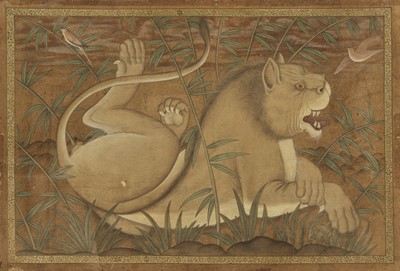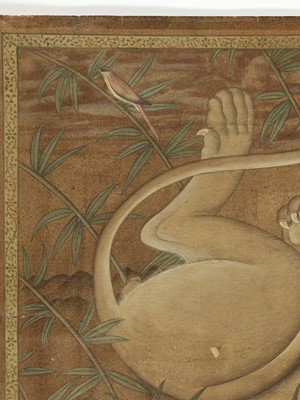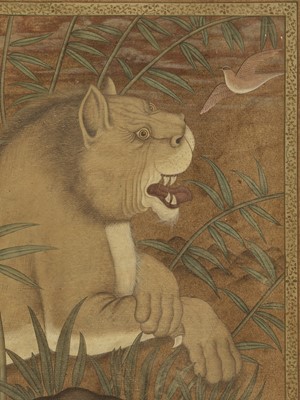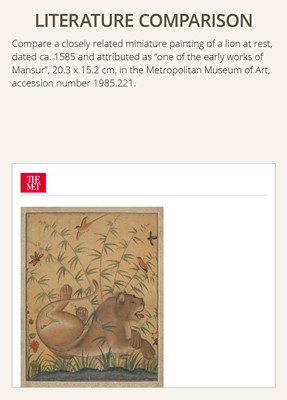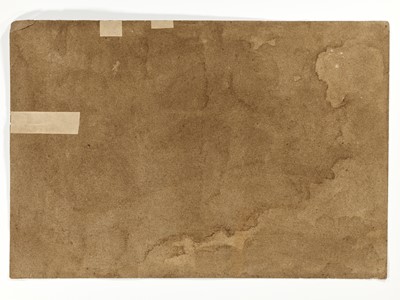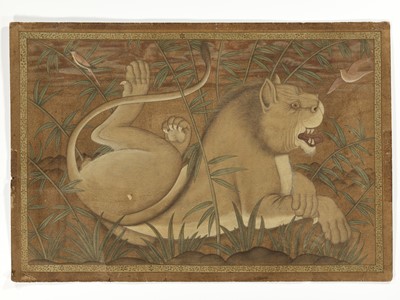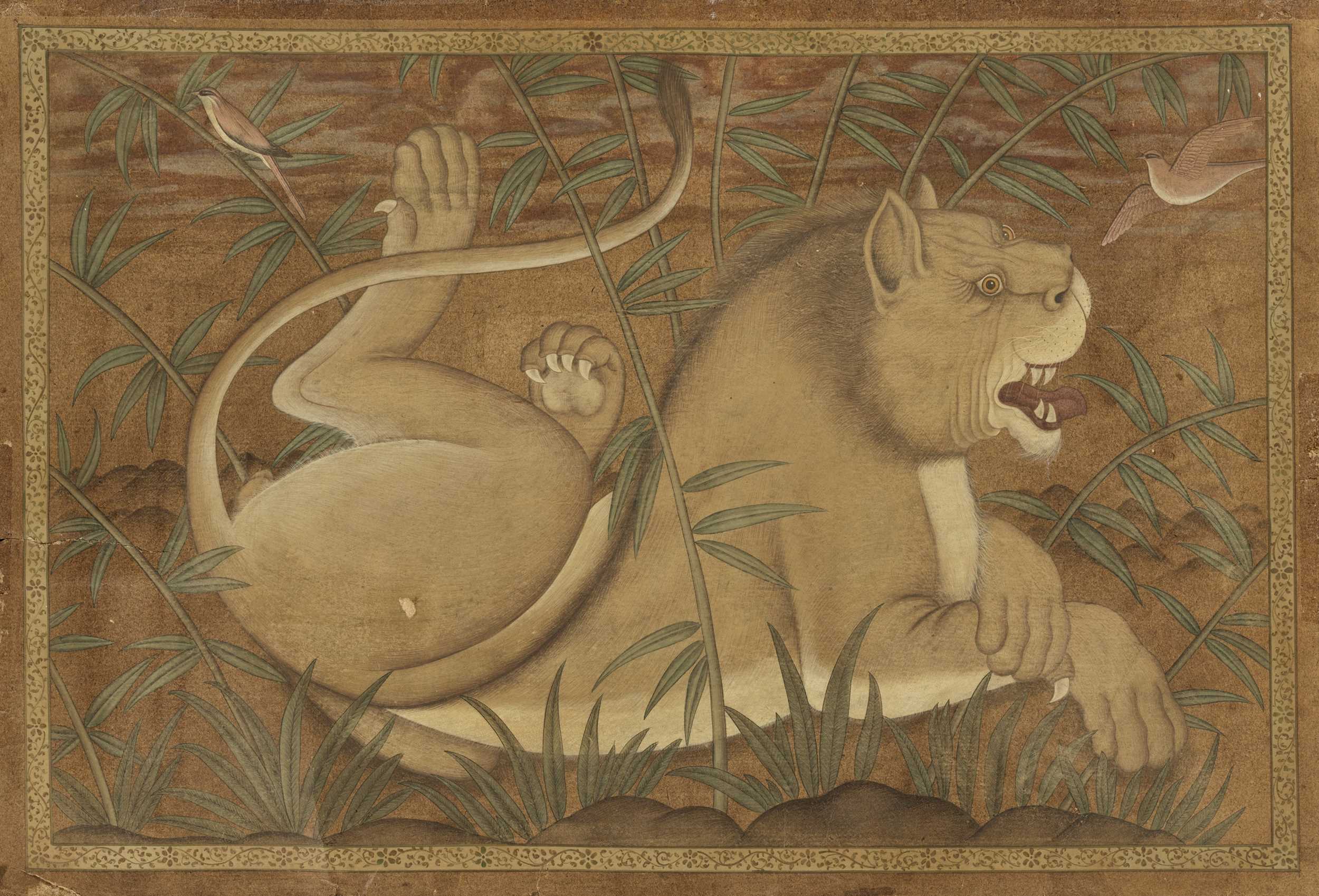29th Sep, 2022 13:00
DAY 1 - TWO-DAY AUCTION - Fine Chinese Art / 中國藝術集珍 / Buddhism & Hinduism
264
‘LION AT REST’, MUGHAL EMPIRE
Sold for €7,150
including Buyer's Premium
1526–1857. Watercolors on paper. The resting lion reclining in a bamboo grove within a rocky landscape under dark wispy clouds, raising his hind legs while lightly crossing the fore paws in one of his natural poses. The beast’s face shows a fierce expression with wild eyes and pricked ears, the mouth agape revealing sharp teeth and a long tongue. The fur, mane, and bushy end of the tail finely executed with meticulous linework.
Provenance: English trade, acquired by the last owner at auction in the United Kingdom within the last ten years. Old label ‘CA b’ to lower left corner.
Condition: Good condition with some wear, minor soiling, creasing, few small losses, one repaired tear (approx. 8 cm long) to left edge, further minor tears to edges, the upper margin with old masking tape.
Dimensions: Size 47 x 69 cm
The Mughal Empire was an early-modern empire that controlled much of South Asia between the 16th and 19th centuries. For some two hundred years, the empire stretched from the outer fringes of the Indus river basin in the west, northern Afghanistan in the northwest, and Kashmir in the north, to the highlands of present-day Assam and Bangladesh in the east, and the uplands of the Deccan plateau in south India.
The Mughal artistic tradition, mainly expressed in painted miniatures, as well as small luxury objects, was eclectic, borrowing from Iranian, Indian, Chinese and Renaissance European stylistic and thematic elements. Mughal emperors often took in Iranian bookbinders, illustrators, painters and calligraphers from the Safavid court due to the commonalities of their Timurid styles, and due to the Mughal affinity for Iranian art and calligraphy. Miniatures commissioned by the Mughal emperors initially focused on large projects illustrating books with eventful historical scenes and court life, but later included more single images for albums, with portraits and animal paintings displaying a profound appreciation for the serenity and beauty of the natural world. For example, Emperor Jahangir (reigned 1605–1627) commissioned brilliant artists such as Ustad Mansur (active 1590-1624) to realistically portray unusual flora and fauna throughout the empire.
Literature comparison:
Compare a closely related miniature painting of a lion at rest, dated ca. 1585 and attributed as “one of the early works of Mansur”, 20.3 x 15.2 cm, in the Metropolitan Museum of Art, accession number 1985.221.
1526–1857. Watercolors on paper. The resting lion reclining in a bamboo grove within a rocky landscape under dark wispy clouds, raising his hind legs while lightly crossing the fore paws in one of his natural poses. The beast’s face shows a fierce expression with wild eyes and pricked ears, the mouth agape revealing sharp teeth and a long tongue. The fur, mane, and bushy end of the tail finely executed with meticulous linework.
Provenance: English trade, acquired by the last owner at auction in the United Kingdom within the last ten years. Old label ‘CA b’ to lower left corner.
Condition: Good condition with some wear, minor soiling, creasing, few small losses, one repaired tear (approx. 8 cm long) to left edge, further minor tears to edges, the upper margin with old masking tape.
Dimensions: Size 47 x 69 cm
The Mughal Empire was an early-modern empire that controlled much of South Asia between the 16th and 19th centuries. For some two hundred years, the empire stretched from the outer fringes of the Indus river basin in the west, northern Afghanistan in the northwest, and Kashmir in the north, to the highlands of present-day Assam and Bangladesh in the east, and the uplands of the Deccan plateau in south India.
The Mughal artistic tradition, mainly expressed in painted miniatures, as well as small luxury objects, was eclectic, borrowing from Iranian, Indian, Chinese and Renaissance European stylistic and thematic elements. Mughal emperors often took in Iranian bookbinders, illustrators, painters and calligraphers from the Safavid court due to the commonalities of their Timurid styles, and due to the Mughal affinity for Iranian art and calligraphy. Miniatures commissioned by the Mughal emperors initially focused on large projects illustrating books with eventful historical scenes and court life, but later included more single images for albums, with portraits and animal paintings displaying a profound appreciation for the serenity and beauty of the natural world. For example, Emperor Jahangir (reigned 1605–1627) commissioned brilliant artists such as Ustad Mansur (active 1590-1624) to realistically portray unusual flora and fauna throughout the empire.
Literature comparison:
Compare a closely related miniature painting of a lion at rest, dated ca. 1585 and attributed as “one of the early works of Mansur”, 20.3 x 15.2 cm, in the Metropolitan Museum of Art, accession number 1985.221.
Zacke Live Online Bidding
Our online bidding platform makes it easier than ever to bid in our auctions! When you bid through our website, you can take advantage of our premium buyer's terms without incurring any additional online bidding surcharges.
To bid live online, you'll need to create an online account. Once your account is created and your identity is verified, you can register to bid in an auction up to 12 hours before the auction begins.
Intended Spend and Bid Limits
When you register to bid in an online auction, you will need to share your intended maximum spending budget for the auction. We will then review your intended spend and set a bid limit for you. Once you have pre-registered for a live online auction, you can see your intended spend and bid limit by going to 'Account Settings' and clicking on 'Live Bidding Registrations'.
Your bid limit will be the maximum amount you can bid during the auction. Your bid limit is for the hammer price and is not affected by the buyer’s premium and VAT. For example, if you have a bid limit of €1,000 and place two winning bids for €300 and €200, then you will only be able to bid €500 for the rest of the auction. If you try to place a bid that is higher than €500, you will not be able to do so.
Online Absentee and Telephone Bids
You can now leave absentee and telephone bids on our website!
Absentee Bidding
Once you've created an account and your identity is verified, you can leave your absentee bid directly on the lot page. We will contact you when your bids have been confirmed.
Telephone Bidding
Once you've created an account and your identity is verified, you can leave telephone bids online. We will contact you when your bids have been confirmed.
Classic Absentee and Telephone Bidding Form
You can still submit absentee and telephone bids by email or fax if you prefer. Simply fill out the Absentee Bidding/Telephone bidding form and return it to us by email at office@zacke.at or by fax at +43 (1) 532 04 52 20. You can download the PDF from our Upcoming Auctions page.
How-To Guides
How to Create Your Personal Zacke Account
How to Register to Bid on Zacke Live
How to Leave Absentee Bids Online
How to Leave Telephone Bids Online
中文版本的操作指南
创建新账号
注册Zacke Live在线直播竞拍(免平台费)
缺席投标和电话投标
Third-Party Bidding
We partner with best-in-class third-party partners to make it easy for you to bid online in the channel of your choice. Please note that if you bid with one of our third-party online partners, then there will be a live bidding surcharge on top of your final purchase price. You can find all of our fees here. Here's a full list of our third-party partners:
- 51 Bid Live
- EpaiLive
- ArtFoxLive
- Invaluable
- LiveAuctioneers
- the-saleroom
- lot-tissimo
- Drouot
Please note that we place different auctions on different platforms. For example, in general, we only place Chinese art auctions on 51 Bid Live.
Bidding in Person
You must register to bid in person and will be assigned a paddle at the auction. Please contact us at office@zacke.at or +43 (1) 532 04 52 for the latest local health and safety guidelines.
